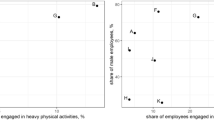Abstract
This study investigates the source of wage differentials between blacks, Hispanics, and whites, and between women and men, in metropolitan Dade County (Florida) government, and draws out the implications of this analysis for affirmative action planning. Our distinctive finding is that the primary factor causing observed wage differentials by ethnicity is the sorting of people across occupational categories. Wage decompositions reveal that for males, 70 percent, 88 percent, and 47 percent of the wage gaps between white and black, white and Hispanic, and Hispanic and black, respectively, are attributable to occupation. For females, the corresponding figures are 56 percent, 58 percent, and 51 percent. When comparing men and women of the same ethnic group, occupational employment patterns are found to be an important factor accounting for lower average female wages, yet within major occupational groups women seem to be receiving higher wages (on average) than men.
Similar content being viewed by others
Notes
For exceptions, see G. Borjas, “Wage Determination in the Federal Government: The Role of Constituents and Bureaucracy,”Journal of Political Economy vol. 88, no. 6 (December 1980); M. W. Reder, “The Theory of Employment and Wages in the Public Sector,” inLabor in the Public and Nonprofit Sectors, D. S. Hammermesh (ed.), (Princeton, NJ: Princeton University Press, 1975); S. P. Smith, “Government Wage Differentials by Sex,”Journal of Human Resources vol. 11, no. 2 (1976); and Sharon Smith,Equal Pay in the Public Sector: Fact or Fantasy (Princeton University, Industrial Relations Section, 1977).
See G. Borjas, “The Earnings of Male Hispanic Immigrants in the United States,”Industrial and Labor Relations Review (April 1982); and, “Immigrants, Minorities, and Labor Market Competition,”Industrial and Labor Relations Review (April 1987).
For discussions of this methodology see A. S. Blinder, “Wage Discrimination—Reduced Form and Structural Estimates,”Journal of Human Resources (Fall 1973); R. Oaxaca, “Male-Female Wage Differentials in Urban Labor Markets,”International Economic Review (October 1973); C. W. Reimers, “Labor Market Discrimination Against Hispanic and Black Men,”Review of Economics and Statistics (November 1983); and J. Cotton, “On the Decomposition of Wage Differentials,”The Review of Economics and Statistics, 70 (May 1988).
Although Blinder originally separately reported the difference in the intercepts, we have grouped together the intercept terms with the coefficients since, as shown by F. Jones, “On Decomposing the Wage Gap: A Critical Comment on Blinder’s Method,”Journal of Human Resources, 18 (Winter 1983), if the intercepts are omitted from the coefficients their value will depend on the units of measurement of the explanatory variables and the reference categories chosen for the dummies.
109B S.Ct. 2115(1989).
Ibid., p., 2116.
109A S.Ct. 707(1989).
NAACP, “The Crisis Magazine” (December 1989), p. 33.
The State of Black America: 1990 (New York: The National Urban League, 1990), p. 3.
109AS. Ct. 707(1989).
Browning, Marshall, and Tabb,Protest is Not Enough (Berkeley, CA: University of California Press, 1984), p. 169. The importance of attaining an equitable share of public sector jobs was recognized at a very early stage in the civil rights movement — see the National Advisory Commission on Civil Disorders,The Report of the National Advisory Commission on Civil Disorders (New York: Bantam, 1968), pp. 413–423; and Alan Altshuler,Community Control (New York: Western Publishing, 1970), pp. 151–189.
See P. K. Eisinger, “Black Employment in Municipal Jobs: The Impact of Black Political Power,”The American Political Science Review Vol. 76, no. 2 (1982), pp. 380–391; G. Hall and A. Saltzstein, “Equal Employment Opportunity for Minorities in Municipal Government,”Social Science Quarterly Vol. 57, no. 4 (March 1977), pp. 864–871; M. Hutchins and L. Sigelman, “Black Employment in State and Local Governments: A Comparative Analysis,”Social Science Quarterly, Vol. 62, no. 1 (March 1981), pp. 79–86; and K. R. Mladenka, “Blacks and Hispanics in Urban Politics,”American Political Science Review, Vol. 83, no. 1 (March 1989), pp. 165–191.
In future research it would be useful to explicitly treat the pattern of occupational employment as endogenous when estimating wage differentials by ethnicity and gender. See T. L. Idson and D. J. Feaster, “A Selectivity Model of Employer-Size Wage Differentials,”Journal of Labor Economics (January 1990) for a modified sample selection methodology that would allow for this type of estimation.
About this article
Cite this article
Idson, T.L., Price, H.F. Analysis of wage differentials by gender and ethnicity in the public sector. The Review of Black Political Economy 20, 75–98 (1992). https://doi.org/10.1007/BF02689935
Issue Date:
DOI: https://doi.org/10.1007/BF02689935




